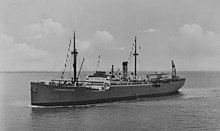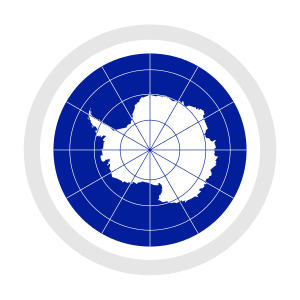New Swabia
| New Swabia Neuschwabenland | |
|---|---|
| Defunct Antarctic claim of Nazi Germany | |
| 1939–1945 | |
 Territory comprising New Swabia marked in red | |
| Historical era | World War II |
• Contact reached | 19 January 1939 |
| 9 April 1940 | |
• Surrender of Germany | 8 May 1945 |
New Swabia (Norwegian and German: Neuschwabenland) was a disputed Antarctic claim by Nazi Germany within the Norwegian territorial claim of Queen Maud Land and is now a cartographic name sometimes given to an area of Antarctica between 20°E and 10°W in Queen Maud Land.[citation needed] New Swabia was explored by Germany in early 1939 and named after that expedition's ship, Schwabenland, itself named after the German region of Swabia.[1][2]
Background
Like many other countries,
The first German expedition to Antarctica was the
German Antarctic Expedition (1938–1939)
The third

On 17 December 1938, the New Swabia Expedition left Hamburg for Antarctica aboard


On its return trip to Germany, the expedition made oceanographic studies near Bouvet Island and Fernando de Noronha, arriving back in Hamburg on 11 April 1939. Meanwhile, the Norwegian government had learned about the expedition through reports from whalers along the coast of Queen Maud Land. Although some, notably Norwegian writer Bjarne Aagaard and German geographer Ernst Herrmann, have claimed that Germany never actually occupied the territory, it is well documented that Germany issued a decree about the establishment of a German Antarctic Sector called New Swabia after the expedition's return in August 1939.[2][10]
Germany never advanced any territorial claims to the region, which were abandoned in 1945.[11]
Geographic features mapped by the expedition
Because the area was first explored by a German expedition, the name Neuschwabenland (New Swabia) is still used for the region on some maps, as are many of the German names given to its geographic features.
- Ahlmann Ridge
- Alan Peak
- Aurdalsegga Ridge
- Austvorren Ridge
- Boreas Nunatak
- Borg Massif
- Cape Sedov
- Conrad Mountains
- Dalsnatten Crag
- Drygalski Mountains
- Dvergen Hill
- Dyna Hill
- Filchner Mountains
- Fjellimellom Valley
- Fimbul Ice Shelf
- Gamaleya Rock
- Gessner Peak
- Gburek Peaks
- Gneiskopf Peak
- Gockel Ridge
- Habermehl Peak
- Herrmann Mountains
- Høghamaren Crag
- Horgebest Peak
- Hortebrekka Slope
- Horteflaket Névé
- Humboldt Mountains
- Isdalen Valley
- Isdalsegga Ridge
- Isfossnipa Peak
- Ising Glacier
- Isingsalen Saddle
- Isingufsa Bluff
- Istind Peak
- Kal'vets Rock
- Knut Rocks
- Kraul Mountains
- Kruber Rock
- Kvamsgavlen Cliff
- Kvitkleven Cirque
- Kvitskarvhalsen Saddle
- Låghamaren Cliff
- Lake Untersee
- Luna-Devyat' Mountain
- Mount Dallmann
- Mount Dobrynin
- Mount Krüger
- Mount Neustruyev
- Mount Zimmermann
- Mount Zuckerhut
- Mühlig-Hofmann Mountains
- New Swabia
- Orvin Mountains
- Payer Mountains
- Penck Trough
- Per Rock
- Petermann Ranges
- Preuschoff Range
- Rømlingsletta Flat
- Rindehallet Slope
- Ritscher Peak
- Ritscher Upland
- Saetet Cirque
- Sandeggtind Peak
- Schirmacher Oasis
- Schirmacher Ponds
- Shatskiy Hill
- Sjøbotnen Cirque
- Skaret Pass
- Skeidskar Gap
- Skimten Hill
- Slithallet Slope
- Sørskeidet Valley
- Stabben Mountain
- Steinbotnen Cirque
- Storeidet Col
- Storkvarvet Mountain
- Storsåtklubben Ridge
- Südliche Petermann Range
- Sverdrup Mountains
- Sverre Peak
- Terningen Peak
- Tindeklypa
- Torgny Peak
- Tysk Pass
- Utrista Rock
- Vestskotet Bluff
- Vorposten Peak
- Weyprecht Mountains
- Wohlthat Mountains
- Zhil'naya Mountain
- Zwiesel Mountain
Aftermath
Germany made no formal territorial claims to New Swabia.
Conspiracy theories
Neuschwabenland has been the subject of conspiracy theories for decades, some of them related to Nazi UFO claims. Most assert that, in the wake of the German expedition of 1938–39, a huge military base was built there. After the war, high-ranking Nazis, scientists, and elite military units are claimed to have survived there. The US and UK have supposedly been trying to conquer the area for decades, and to have used nuclear weapons in this effort. Proponents claim the base is sustained by hot springs providing energy and warmth.[16]
The WDR radio play "Neuschwabenland-Symphonie" from 2012 takes up the conspiracy theories.[17]
See also
- Antarctica during World War II
- Esoteric Nazism
- List of Antarctic expeditions
- Operation Highjump
- Yamato Yukihara
References
- ^ , p. 367
- ^ a b Widerøe, Turi (2008). "Annekteringen av Dronning Maud Land". Norsk Polarhistorie (in Norwegian). Archived from the original on 24 September 2015. Retrieved 15 July 2011.
- ^ Luke Fater (6 November 2019). "Hitler's Secret Antarctic Expedition for Whales". Atlas Obscura. Retrieved 27 February 2021.
- ^ Eric Niiler. "Hitler Sent a Secret Expedition to Antarctica in a Hunt for Margarine Fat". A&E Television Networks, LLC. Retrieved 27 February 2021.
- ^ a b "Hitler's Antarctic base: the myth and the reality" Archived 13 December 2016 at the Wayback Machine, by Colin Summerhayes and Peter Beeching, Polar Record, Volume 43 Issue 1, pp. 1–21. Cambridge University Press, 2007.
- ^ "Former German Colonies and Overseas Territories".
- ^ a b Boudewijn Büch. Eenzaam, Eilanden 2 ('Lonely, Islands 2'), Holland 1994
- ^ Ritscher's expedition report, more information pending
- ISBN 978-1-57607-422-0.
- ^ The International Hydrographic Review. International Hydrographic Bureau. 1943.
- ^ Jacek Machowski (1977). The Status of Antarctica in the Light of International Law. Office of Polar Programs and the National Science Foundation.
- ^ e.g., National Geographic Atlas of the World, Eighth Edition, 2005
- ^ USGS GNIS
- OCLC 907129665
- ^ "Queen Maud Land". Encyclopædia Britannica. Retrieved 25 April 2011.
- ^ Holm Hümmler: Neuschwabenland – Verschwörung, Mythos oder Ammenmärchen? In: Skeptiker. Nr. 3, 2013, S. 100–106.
- ^ "ARD-Hörspieldatenbank". hoerspiele.dra.de. Retrieved 19 December 2021.
Literature
- Murphy, D.T. (2002). German exploration of the polar world. A history, 1870–1940 Lincoln : University of Nebraska Press. OCLC 48084187
External links
- Photographs of the MS Schwabenland and its seaplanes (in German)
- More photographs of the MS Schwabenland (in German)
- Erich von Drygalski and the 1901–03 German Antarctic Expedition, Scott Polar Research Institute
- Wilhelm Filchner and the 1911–12 German Antarctic Expedition, Scott Polar Research Institute
- Kartographische Arbeiten und deutsche Namengebung in Neuschwabenland, Antarktis
- Dunning, Brian (21 February 2017). "Skeptoid #559: Hitler's Antarctic Fortress Unmasked". Skeptoid.




